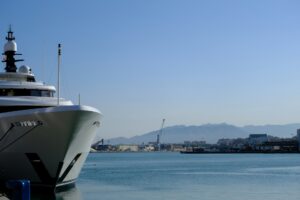Step Aboard: Why This Three-Letter Term Matters
The teak deck is warm under your feet. In the galley below, chefs unpack produce flown in from Provence. The captain quietly checks fuel burn for the next hop to Corsica. None of this appears on your “base charter fee” — yet all of it happens seamlessly because of APA — Advance Provisioning Allowance.
If you’ve ever asked “what is APA in yacht charter?” or wondered why your broker asks for an extra 30–40% on top of the charter fee, this is the clearest, most complete answer. You’ll discover not just the definition, but how APA shapes your trip, how to budget it, and how to use it to your advantage.
What Is APA in a Yacht Charter — Why It Matters
APA = Advance Provisioning Allowance — a pre-paid onboard expense account to cover all the variable running costs of your yacht charter.
It’s collected before you board, managed by your captain, and reconciled after the trip. APA covers things like:
-
Fuel for yacht and tenders
-
Food and beverage provisioning
-
Marina and port fees
-
Communications and utilities
-
Special requests arranged by the crew
What APA does not cover: the base charter fee itself, taxes, crew gratuities, and security deposits.
Why APA Exists — and Why It Benefits You
Luxury yachts operate like private floating hotels. Every voyage is unique: one guest might island-hop at 22 knots with premium Champagne; another might anchor quietly for days with local wines. Rather than padding the charter fee for a “worst-case” spend, APA keeps pricing transparent and fair:
-
You prepay an allowance based on an estimate.
-
The yacht spends from it during your trip.
-
Unused funds are refunded; if you spend more, you top up.
In practice, it’s the only system that allows high-end customization without constant onboard billing.

How Much APA to Expect (Percentages by Yacht Type)
-
Sailing yachts: 20–30% of base charter fee (low fuel burn; provisioning main driver).
-
Displacement motor yachts: 30–35% (steady generator use, moderate fuel).
-
Fast planing motor yachts: 35–40%+ (high speed + high fuel consumption).
A €100,000 weekly charter could therefore carry a €30,000–€40,000 APA. Understanding your yacht type and cruising style helps you budget accurately.
What APA Covers in Detail
Fuel
The biggest swing factor. Fast passages and frequent tender trips consume far more fuel than gentle cruising and anchoring. Example: a 40m motor yacht might burn 500–700 litres/hour at speed; a sailing yacht under sail uses almost nothing.
Food & Beverages
APA covers provisioning tailored to your preference sheet — from local rosé and fresh lobster to niche dietary needs. Costs scale with quality and quantity.
Marina & Port Fees
Prime berths in Riviera marinas during peak events can cost thousands per night.
Communications & Utilities
Satellite internet, water makers, laundry and even onshore power can come through APA. Heavy streaming offshore? That bandwidth comes from your allowance.
Special Requests
Helicopter transfers, private guides, flowers, event tickets, spa therapists — if arranged through the crew, it’s typically paid from APA.
What APA Does Not Cover
-
Base charter fee (yacht, crew salaries, insurance).
-
VAT or local taxes stated separately.
-
Crew gratuity (customary but discretionary, often 10–15% of base fee).
-
Security deposits or damage waivers for certain toys or cancellation cover.
Think of APA as “running costs”; gratuity and taxes are “after-service” or statutory items.
How APA Works Before, During, and After
Before Boarding
Your broker quotes APA alongside the charter fee. You transfer funds with your final payment, usually 4–6 weeks before embarkation. The captain then uses your preference sheet to order food, fuel, and plan berths.
During the Charter
The captain manages APA spending, logging receipts daily. You can request a running balance. Changes in itinerary, last-minute parties, or unexpected fuel prices can push spending beyond the deposit — in that case, you’ll be asked for a top-up.
After the Charter
The captain provides a detailed final account. Any unspent funds are refunded promptly, often within a few business days. If costs exceeded the deposit and you didn’t top up during the trip, you settle the difference.
Costs Without Clickbait: Real Drivers of APA
| Cost Driver | Why It Matters | How to Manage It |
|---|---|---|
| Fuel | Speed, distance, generator hours, tender use. | Plan efficient routes; cruise at economical speeds; cluster tender trips. |
| Provisioning | Premium brands, dietary needs, last-minute adds. | Provide detailed preference sheet early; approve substitutions. |
| Marina Choices | Peak-season berths cost far more. | Mix anchorages with marinas; avoid major events nights. |
| Water Toys & Extras | Added fuel, extra crew time. | Group sessions; pick toys you’ll actually use. |
| Comms & Utilities | Satellite bandwidth, water, laundry. | Download heavy files in port; moderate offshore streaming. |
Example APA Breakdown — €100,000 Motor Yacht Charter
| Item | Spend (€) | Notes |
|---|---|---|
| Fuel (yacht + tender) | 12,000 | Two long passages + daily tenders |
| Food & Beverages | 11,500 | Premium menus, special wine list |
| Marinas & Port Fees | 4,200 | Three Riviera marinas incl. event night |
| Comms & Utilities | 1,800 | Wi-Fi, sat phone, laundry |
| Special Requests | 2,000 | Airport transfers + private guide |
| Total APA Spend | 31,500 | Out of €35,000 APA deposit |
| Refund to Guest | 3,500 | Returned within days of disembarkation |
Same yacht, slower pace, more anchoring? Fuel might drop to €7–8k and refund increases accordingly.

Why APA Beats “All-Inclusive” Models
-
Transparency: You see exactly where your money goes.
-
Customization: You choose the Champagne, the route, the berths.
-
Fair Pricing: Base fees aren’t bloated “just in case.”
-
Flexibility: You can change plans mid-week without renegotiating.
Smart Tips to Master Your APA
-
Preference Sheet Precision: Brands, bottle prices, portion sizes — the more detail, the better the provisioning.
-
Ask for an Estimated Breakdown: Fuel vs. food vs. marinas.
-
Review Mid-Week: Five-minute check-in avoids surprises.
-
Understand Speed & Distance: Cruising at 12 knots instead of 20 can halve fuel burn.
-
Be Tender-Smart: Cluster shore trips; avoid constant shuttles.
-
Communicate Changes Early: Adding guests, extra toys, or big events? Let the crew know.
-
Retain a Cushion: Even with precise planning, keep 5–10% aside for spontaneity.
Myths and Edge Cases (Clearing Up Confusion)
-
“APA is a tip.” No. Crew gratuity is separate, typically 10–15% of base fee, paid at the end.
-
“APA is taxed.” VAT applies to the charter fee, not to APA, though some local fees can pass through.
-
“Every yacht uses APA.” Most Mediterranean luxury charters do; smaller Caribbean boats sometimes run all-inclusive.
-
“APA disappears.” It’s fully receipted, reconciled, and refunded if unused.
-
“APA = security deposit.” Not the same; security covers potential damage, APA funds running costs.
-
“Card or Wire?” Standard practice is bank transfer for the deposit; small top-ups by card may incur a fee.
-
“Currency Confusion.” APA is held in the contract currency to avoid double conversions.
-
“Static charters.” If the yacht stays in port, fuel drops but marina fees and provisioning remain.
FAQ — What People Also Ask About APA in Yacht Charters
1. What does APA mean in yacht charter contracts?
Advance Provisioning Allowance — a prepaid budget for running costs such as fuel, provisioning, marinas and utilities.
2. How much APA should I budget for different yachts?
Sailing yachts 20–30%; motor yachts 30–40% of base fee.
3. What expenses are included in APA?
Fuel, food & drinks, port/marina fees, comms/utilities, and guest-requested extras arranged by the crew.
4. Is APA refundable after the charter ends?
Yes. Unused funds are refunded promptly with a final statement.
5. Does APA cover crew gratuity?
No. Tips are separate, optional, and typically 10–15% of the base fee.
6. Who manages APA during the charter?
Your captain, who keeps receipts and a running balance.
7. Can APA be paid by credit card or must it be wired?
Deposits are almost always by bank transfer. Some yachts accept cards for small top-ups with a processing fee.
8. Is APA standard worldwide?
The mechanism is standard for crewed charters; only the percentages and what’s typical vary.
9. Can APA be topped up mid-charter?
Yes, if costs exceed your deposit and you wish to continue at the same pace or add extras.
10. Is APA mandatory on every yacht?
Most crewed yachts use it; some smaller or niche charters do not.
APA vs All-Inclusive Charters — At a Glance
| Feature | APA Charter (Advance Provisioning Allowance) | All-Inclusive Charter |
|---|---|---|
| Base Fee | Lower, covers yacht + crew | Higher, includes estimated consumables |
| Flexibility | High: fuel, menus, marinas per guest choice | Moderate: fixed inclusions |
| Transparency | Receipts, refunds, top-ups | Less itemized |
| Ideal For | Guests wanting customization & control | Guests wanting predictability & simplicity |
Plan Your Next Charter With Ease
Step Aboard With Confidence
Planning a yacht charter soon? Explore our latest guides on charter costs, etiquette, and destination planning — everything you need to arrive prepared and inspired.
Discover Our Charter Concierge
Planning a yacht charter soon? Our Charter Concierge service brings you refined, one-to-one support for planning your next yacht experience. We’re building something new here.Planning your first yacht trip? Don’t miss our First Time Yacht Charter Packing List — a refined, insider guide to what to bring and why.
